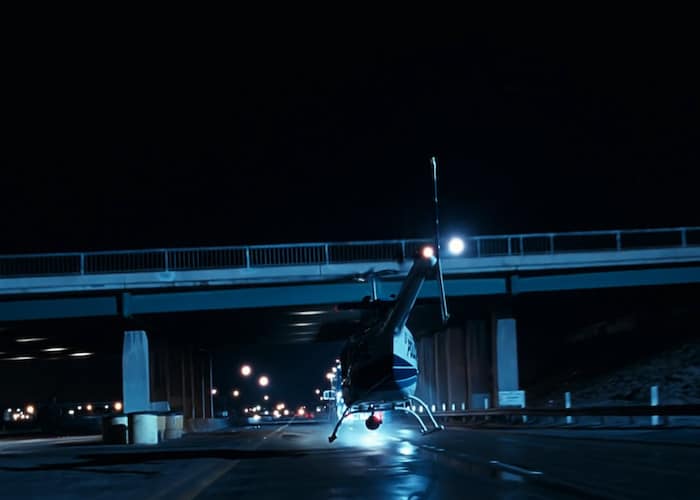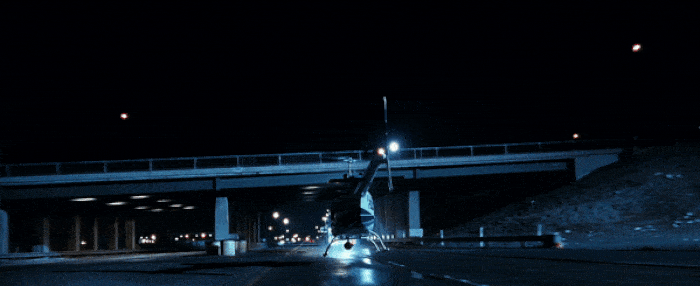Submarine With Tank Tracks and Helicopter Propeller in Movie
Or, as James Cameron puts it in the commentary: "See this helicopter going under a freeway overpass? That's a helicopter going under a freeway overpass."

By · Published on March 20th, 2020
Welcome to How'd They Do That? — a bi-monthly column that unpacks moments of movie magic and celebrates the technical wizards who pulled them off.
James Cameron's filmography is the gold standard when it comes to marrying practical and digital effects. Titanic features some of the first photorealistic computer-generated water…and scenes shot in a 350,000-gallon tank. The Abyss has a groundbreaking CGI character effect…and complex underwater sequences.
But Terminator 2: Judgment Day is a cut above when it comes to uniting practical spectacle and CGI wizardry. And while the digital effect of the shape-shifting T-1000 (Robert Patrick) holds up in its own right, the surrounding practical work carries a weightiness that's often missing from today's CGI-heavy blockbusters. Practical setpieces and FX have an inherent gravity with implied stakes and the power to support storytelling as deftly as dialogue.
The way Cameron shoots practical effects in Judgment Day is bold and coherent, with long, deliberate, in-camera shots that make stunts feel more like choreography than chaos. Cameron may have ushered in the era of CGI filmmaking, but the man is also responsible for some of the most gob-smacking practical set pieces to grace our screens. And more than a good handful of those set pieces are in Judgment Day.
And one of those set pieces contains a stunt that blows my goddamn mind every time I see it.
In Judgment Day's third act our heroes hit the Long Beach Freeway in an armored car, with the terrifying T-1000 in hot pursuit in a helicopter. A nighttime chase ensues with the T-1000 flying mere feet above the highway, firing through his windshield (courtesy of a blink-and-you'll-miss-it extra set of arms). The T-800 (Arnold Schwarzenegger) drives under an overpass—the helicopter will surely back off, right? Wrong.
The T-1000 flies the helicopter underneath the overpass, its blades spinning mere feet beneath the concrete, its skids nearly touching the pavement.

Narratively this is one more notch in the T-1000's belt as a hyper-focused predator. Throughout the film, we've watched this liquid jerk narrow in on his targets with laser-like precision. Of course he'd pursue them under an overpass. But on a technical level, it's a total "oh shit" moment. The kind of "oh shit" moment that raises brows skyward and makes you leap for the rewind button. Did they really just do that? Surely not.
How'd they do that?
Long story short:
As James Cameron puts it in the director's commentary: "See this helicopter going under a freeway overpass? That's a helicopter going under a freeway overpass."
Long story long:
The idea of flying the Bell JetRanger under the overpass was all James Cameron's idea because of course it was. Cameron has made a career out of being an "all or nothing" kind of director, and his approach to this helicopter stunt was no different. In fact, storyboards indicate that originally, believe it or not, the entire chase scene was going to take place in a tunnel with the use of miniatures. When this proved unfeasible, the location was moved to the Long Beach freeway, and Cameron's big dream of a tunnel chase was relegated to the overpass stunt.
In an interview with Female for the film's 3D re-release, Cameron addresses the obvious: "we could've run a CG helicopter under the freeway overpass, but it was so much more fun to do the real thing." In other words: it's not that alternatives to flying an actual helicopter under an overpass weren't possible, it's just that those alternatives were for cowards.
The stunt was performed by Charles A. "Chuck" Tamburro, a veteran stunt pilot as well as an actual, you know, veteran (Tamburro learned to fly helicopters in Vietnam). You might not know his name, but you've almost certainly seen Tamburro's work. He's piloted helicopters in everything from Predator, to Furious 7, to Scarface, to Blade Runner.


Fun fact: the pilot of the commandeered helicopter is actually played by Tamburro himself. Technically, he did not "get out."
According to James R. Chiles' The God Machine: From Boomerangs to Black Hawks, The Story of the Helicopter, Tamburro put his helicopter on wheels and rolled it under the bridge to measure the clearance, which came to five feet above and four feet on each side. Tamburro flew the stunt at a speed of sixty knots, roughly 70 mph or 111 km/h, (aka highway speed for those of you who don't drive).
I was curious about how the overpass would affect the ground effect of the helicopter. Tragically, I have no brain for physics. But I do know a helicopter pilot, so I asked him. Apparently, at 60 kts, there wouldn't be significant ground effect because the down flowing air off of the rotor disk would mostly be tailing off of the helicopter. Had Tamburro taken the stunt slower, the down flowing air would be more directly underneath the helicopter, creating an (obviously undesirable) effect.
With a lot at stake and not a lot of room for error (quite literally), as Tamburro, himself put it: "If I made a mistake, I would be killed." The stunt was so obviously dangerous that the scheduled camera crew tasked with shooting the close-ups refused to take part in it. Proving that he's not one to ask of others what he isn't willing to do himself, Cameron said "okay fine, I'll shoot it" and shot the stunt with the help of a very courageous insert car driver.
The only thing more impressive than Tamburro pulling off this stunt is that he pulled it off twice. See, Cameron needed to capture two different angles: one from behind the helicopter and one in front of it. How Tamburro was able to pilot the helicopter with his enormous balls we'll never know.
As if the stunt being dangerous as hell wasn't enough of a challenge, the chase sequence itself was already a headache to orchestrate. A profile on the film by American Cinematographer (a valued resource of this column) provides some insight into the demanding sequence.
A full crew worked for two weeks just on the pre-rig. During the chase scene (overpass excluded) the police helicopter used by the T-1000 was hung by a moving crane to make it look like it was flying, which safely allowed for shots of Robert Patrick firing and reloading his gun.
One of the most challenging parts was lighting the sequence, according to the film's DP Adam Greenberg: "we had to light up the Long Beach Freeway for five and a half miles, just for this one scene…the requirement of the director was that we do all five and a half miles in one piece, at one time, so we would be able to continuously shoot the run. Jim wanted to be able to shoot the sequence from the helicopter, from an insert car, from all over. It was tricky." Apparently they had to rent every existing cable from every studio; "there weren't enough cables in Holywood to run this five and a half miles!" According to Greenberg, the shoot lasted for about three weeks of night shoots on the freeway.
What's the precedent?
The cinematic history of flying helicopters through tunnels is not well documented and is potentially non-existent. And with good reason: helicopter crashes have claimed a lot of lives on film and television sets.
I thought I'd found a comparable stunt in the cold open of 1981's For Your Eyes Only,in which James Bond (Roger Moore) is pursued by a remote-controlled helicopter piloted by Blofeld. At one point in the sequence, the Bell JetRanger flies slowly through the open girders of an industrial building and out the other side. Alas: forced perspective, miniatures, and a dummy helicopter ran on tracks were used for the stunt. So no dice.

It may very well be that James Cameron—who isn't just a tyrant director, but a tyrant director willing to put himself in danger—was doing something novel here, to a degree.
It is also possible that the Judgment Day overpass-pass was a case of an equally cavalier director and pilot yes-anding themselves into a wild stunt (perhaps a precedent to the heavenly match of Brad Bird and Tom Cruise in Mission: Impossible – Ghost Protocol).
We should also remember that you can barely finish typing J-a-m-e-s C-a-m-e-r-o-n into Google before you're up to your eyelids in evidence of the director's brazen, wanton disregard for the safety of himself and others. From reports of Cameron nail-gunning ringing phones to the wall on the set of Avatar to the crew of The Abyss making shirts that emblazoned with: "You Can't Scare Me. I Work For James Cameron,"—this is a man who would absolutely risk it all for the sake of a stunt.
And considering it all worked out and no one got hurt, we're kind of glad he did.
Related Topics: How'd They Do That?, Terminator 2

Meg Shields is the humble farm boy of your dreams and a senior contributor at Film School Rejects. She currently runs three columns at FSR: The Queue, How'd They Do That?, and Horrorscope. She is also a curator for One Perfect Shot and a freelance writer for hire. Meg can be found screaming about John Boorman's 'Excalibur' on Twitter here: @TheWorstNun. (She/Her).
Recommended Reading
Watch 'Halloween,' Then Watch These Movies
We recommend 12 movies to seek out after you see David Gordon Green's new horror sequel.Submarine With Tank Tracks and Helicopter Propeller in Movie
Source: https://filmschoolrejects.com/terminator-2-helicopter-stunt/
0 Response to "Submarine With Tank Tracks and Helicopter Propeller in Movie"
Post a Comment